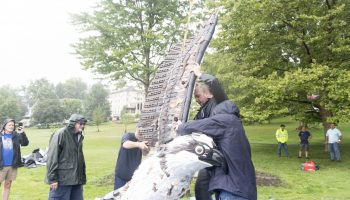Famed entomologist and naturalist E.O. Wilson once said that “only by committing half of the planet’s surface to nature can we hope to save the immensity of life-forms that compose it.”
Environmental organizations of Western New York are approaching their landscape with Wilson’s same assertion in a new wildway that will protect and conserve the wildlife of Chautauqua and neighboring counties.
Chautauquans gathered Monday, Aug. 1 in Smith Wilkes Hall to learn about the Chautauqua Watershed Conservancy and Western New York Land Conservancy’s plan for a new wildway that would protect and conserve wildlife of the area. The event was programmed as a special lecture through Chautauqua’s Climate Change Initiative.
CWC Executive Director John Jablonski III and WNYLC Development Director Jajean Rose-Burney discussed the importance of the wildway and their next steps in implementing the plan within the coming years.

A wildway is a stretch of once-developed land that will restore and sustain the biodiversity of the area. The proposed wildway would encompass lands ranging from Pennsylvania to the Adirondack Mountains and bodies of water from the Great Lakes to the Finger Lakes. Rose-Burney said the best way to understand the wildway was thinking of it as “a corridor for wildlife.”
The wildway will be composed of “core areas” of substantial threat to wildlife that are connected by “linkages.”
While the wildway would be specific to Western New York, it will also contribute to the Wildlands Network, called the Eastern Wildway, which extends from Canada to the Gulf of Mexico. By adding to the Eastern Wildway’s land coverage, the new proposed greenway will provide a clearer path for animals to migrate.
“The reason why wildlife movement, the ability for wildlife to move, is important is because if they get stuck in one patch of land, and they can’t ever leave, you’re going to get a lot of productivity and disease or injury, and eventually they’ll disappear,” Rose-Burney said. “It has to be able to move across the landscape if they’re gonna survive for the next 500,000 years.”
Rose-Burney spoke to the importance of conserving local species by pointing to those that Chautauqua County has lost in the past few decades, including bison, the American chestnut tree and the Carolina parakeet. The region now stands to lose the eastern spiny softshell turtle and the ash tree.
Jablonksi said that if a municipality has over 70% forest cover in lands and watersheds, wildlife can thrive; in the CWC’s most recent survey with doctoral candidate Jonathan Townsend, Chautauqua County only has about 66% forest cover.
Jablonksi said the forest coverage has been steadily sloping down over the last 30 years. The fluctuating population of the county may be a contributing factor to the struggling watershed, especially with commercial agriculture on the decline.
“The population here has dropped significantly over the last 50 years,” Jablonski said. “We have fewer and fewer people using and impacting the land well, which is not good. … As more and more suburban development and recreational home development occurs, this land cover is now going from being more and more forest to less and less forest”
Another phenomenon threatening the forest cover is the implementation of renewable energy facilities. The emissions of toxins into the atmosphere could suffocate surrounding wildlife and deplete the area of water and nutrients that the wildlife need to survive.
“We have both windmills and solar developments, which are a good thing in one sense, but can really threaten the ecological integrity of the area and can impact the areas that we’re trying to save,” Jablonski said. “We have to be really careful as to where those are sited.”
The CWC is currently pursuing geographic information system land cover research and prioritizing conservation mapping to pinpoint areas of needed improvement.
Conserving the natural landscape and restoring it to its former glory is not only crucial for the health of animals, but for humans, as well.
“Especially when the pandemic began, everything shut down,” Rose-Burney said. “A lot of people basically had to seek family or friends in parks, on trails with nature. This wildway is a new system that will help connect people to nature. Connecting people, especially young people, to forests and farms, is so important for the future of conservation, because we don’t have people to love these places. The wildway will give us a framework that is really about connecting people right in the city of Buffalo.”
As the CWC and WNYLC move forward with their plans, they both encourage people in Western New York to look to the long-term in their environment and support their work by staying informed and thinking sustainably about their home.
“It’s a way to rethink the region,” Rose-Burney said. “It’s a way to make the region more sustainable. It’s a way to think about how we are influencing animals to survive as climate changes; maybe we can slow down climate change. But we also prefer an accurate way to connect just to nature. It’s a way to connect plants and animals to other plants and animals. It’s a way to change the way that Western New York looks in the next few years, and it is going to take maybe even centuries after protective action to restore.”




